PART Il: ENGRAVINGS, ETCHINGS, AQUATINTS & LITHOGRAPHS
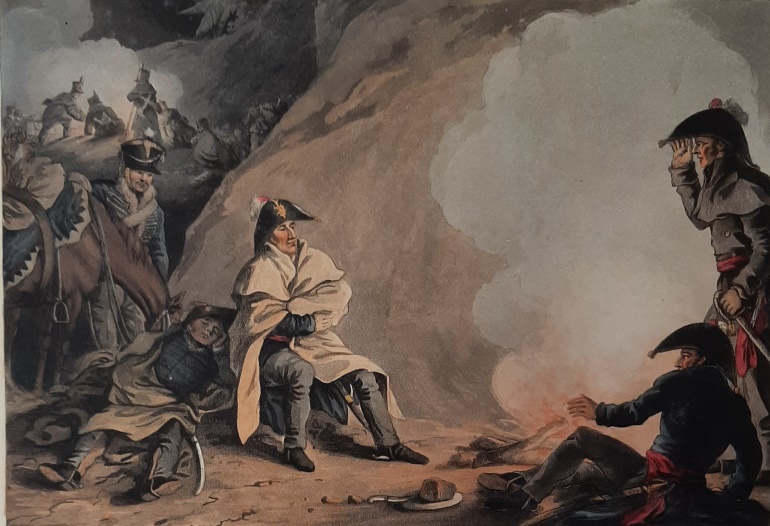
No. 66
66. ATKINSON, John Augustus [c1775-1830] (After). FRY, William Thomas [1789-1843] & Thomas SUTHERLAND [1785-1838] (Engravers). Bivouac In The Pyrenees, The night before the Battle. 10 ½ x 13 5/8 inches (26.7 x 34.6 cm., entire sheet). hand-coloured aquatint. London: Edward Orme, June 4th, 1815. $175
Wellington is shown with four of his officers and a horse around a fire; other soldiers are shown in the background. The Battle of the Pyrenees, July 25-30, 1813 was an unsuccessful large-scale offensive led by Marshal Soult with the aim of relieving French garrisons under siege in Pamplona and San Sebastian. Soult was forced to withdraw in the face of mounting resistance by Wellington and his allied troops. Published in Edward Orme’s ‘Historic, Military, and Naval Anecdotes’, London: 1819.

No. 67
67. ATKINSON, John Augustus [c1775-1830] (After). DUBOURG, Matthew (Engraver). A British Soldier Taking Two French Officers. 10 5/8 x 13 ¾ inches (27 x 34.9 cm., entire sheet). hand-coloured aquatint. London: Edward Orme, Sept. 1, 1815. $175
Published in Edward Orme’s ‘Historic, Military, and Naval Anecdotes’, London: 1819.
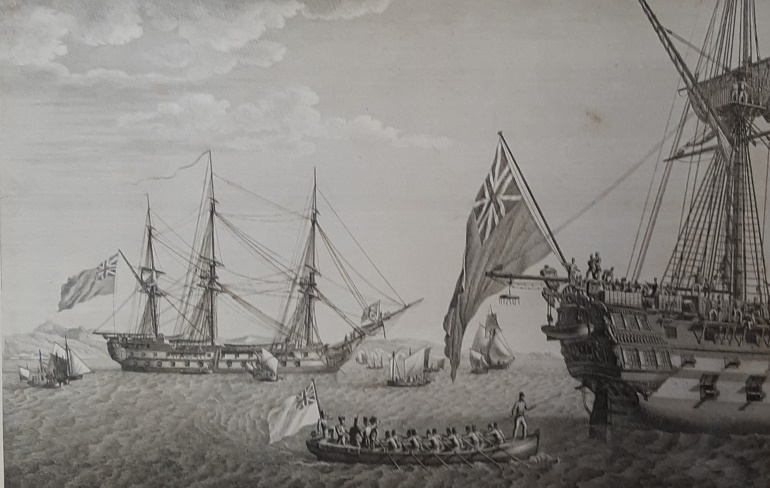
No. 68
68. BAUGEAN, Jean-Jérôme [1764-1819] (After). BOVINET, Edme (Engraver). Transfèrement De Bonaparte Du Bellérophon À Bord Du Northumberland, le 8 Aôut 1815. 12 x 16 ¾ inches (30.5 x 42.5 cm., entire sheet). engraving (tears & holes in margins – 1 entering into image 5/8 of an inch in left sky & several others affecting 3 letters at beginning of caption). [Paris: c1815]. $175
Napoleon surrendered to the British on July 13 and two days later boarded the British warship ‘Bellerophon’. The ship anchored at Plymouth for two weeks while the authorities discussed his fate, finally deciding to exile him to the island of St. Helena. As the ‘Bellerophon’ was an ageing ship, Napoleon was transferred to the 74-gun ‘Northumberland’ for the voyage.
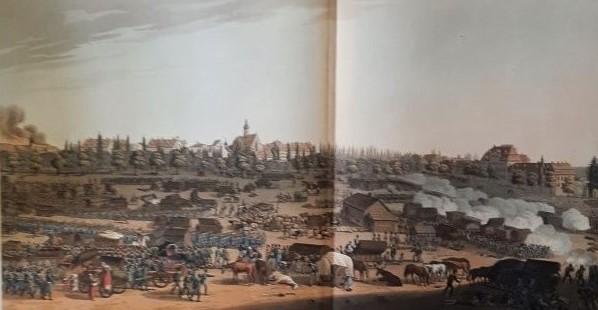
No. 69
69. BOWYER, Robert [1758-1834] (Publisher). Precipitate Flight Of The French Through Leipsic Pursued By The Allied Armies 19th October 1813. From an Original Drawing made on the Spot. 18 5/8 x 23 5/8 inches (47.6 x 61 cm., entire sheet). hand-coloured aquatint (centre fold, tear in lower margin and just below caption, fold in right-hand margin). London: 1815. $500
Napoleon suffered a decisive defeat at the Battle of Leipzig (Battle of the Nations), (Oct. 16–19, 1813), by allied troops, including Austrian, Prussian, Russian, and Swedish forces, commanded respectively by Prince Karl Philipp Schwarzenberg, General Gebhard Leberecht Blücher, General Leonty Leontyevich Bennigsen, and the Swedish crown prince Jean Bernadotte. This resulted in the destruction of what was left of French power in Germany and Poland. Published in Robert Bowyer’s ‘The Triumphs of Europe in the Campaigns of the Years 1812, 1813, 1814’/‘Illustrated Record of Important Events in the Annals of Europe, during the years 1812, 1813, 1814 & 1815’, London: 1814-15.
Abbey, ‘Life in England’, 352.

No. 70
70. BOWYER, Robert [1758-1834] (Publisher). Pursuit Of The French Through Leipsic On The 19th October 1813. with a View of the Entrance into Richter’s Garden, through which Bonaparte made his Escape. 12 ¾ x 18 ¼ inches (32.4 x 46.4 cm., entire sheet). hand-coloured aquatint (3 light soil marks in upper left of plate, only 1 entering image. London: 1 Sept. 1816. $350
Published in Robert Bowyer’s ‘The Triumphs of Europe in the Campaigns of the Years 1812, 1813, 1814’/‘Illustrated Record of Important Events in the Annals of Europe, during the years 1812, 1813, 1814 & 1815’, London: 1814-15? (not on plate list).
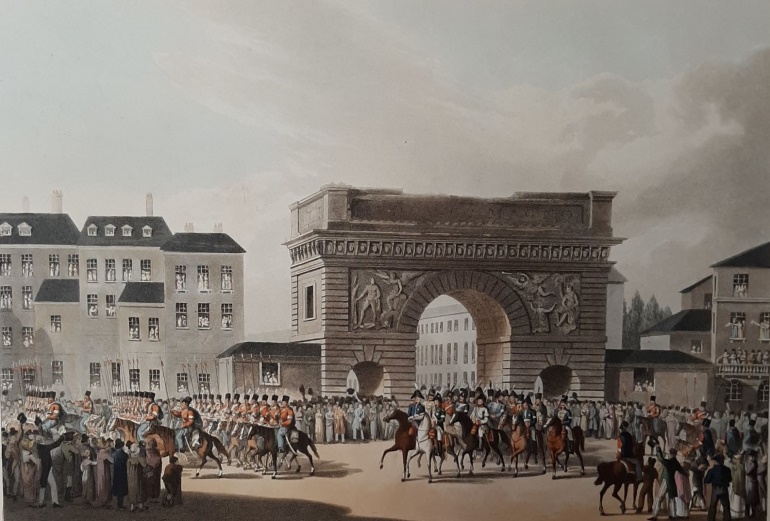
No. 71
71. BOWYER, Robert [1758-1834] (Publisher). Grand Entry Of The Allied Sovereigns Into Paris on the 31st, March 1814. 12 7/8 x 18 5/8 inches (32.7 x 47.6 cm., entire sheet). hand-coloured aquatint ( a few chips to edges). London: 1815. $350
Published in Robert Bowyer’s ‘The Triumphs of Europe in the Campaigns of the Years 1812, 1813, 1814’/‘Illustrated Record of Important Events in the Annals of Europe, during the years 1812, 1813, 1814 & 1815’, London: 1814-15.
Abbey, ‘Life in England’, 352.
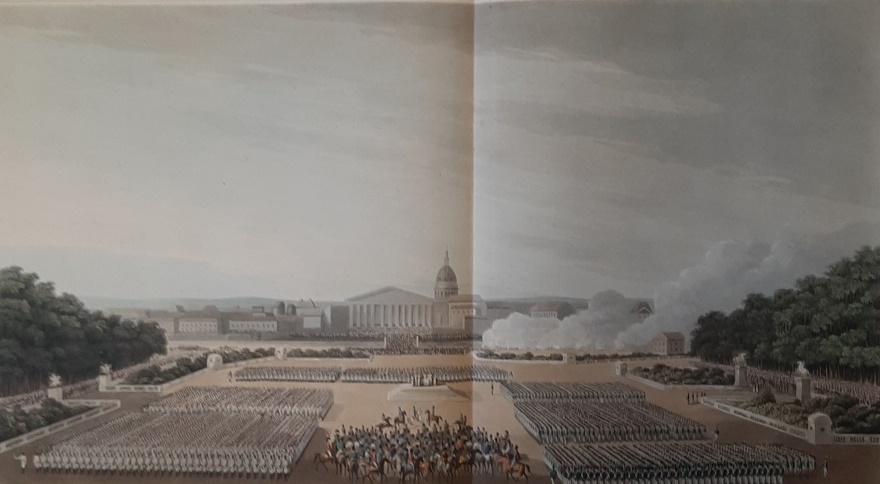
No. 72
72. BOWYER, Robert [1758-1834] (Publisher). Ceremony Of Te Deum By The Allied Armies On The Square Of Louis XV At Paris, The 10th April, 1814. From an Original Drawing made on the Spot during the Ceremony by Moreau. 18 3/4 x 24 inches (47.3 x 61 cm., entire sheet). hand-coloured aquatint (centre fold, fold in right-hand margin). London: 1815. $500
The Battle of Paris was fought on March 30–31, 1814, between the Sixth Coalition, consisting of Russia, Austria, and Prussia, against the French Empire. After a day of fighting in the suburbs, the French surrendered, ending the War of the Sixth Coalition and forcing Emperor Napoleon to abdicate and go into exile. Published in Robert Bowyer’s ‘The Triumphs of Europe in the Campaigns of the Years 1812, 1813, 1814’/‘Illustrated Record of Important Events in the Annals of Europe, during the years 1812, 1813, 1814 & 1815’, London: 1814-15.
Abbey, ‘Life in England’, 352.
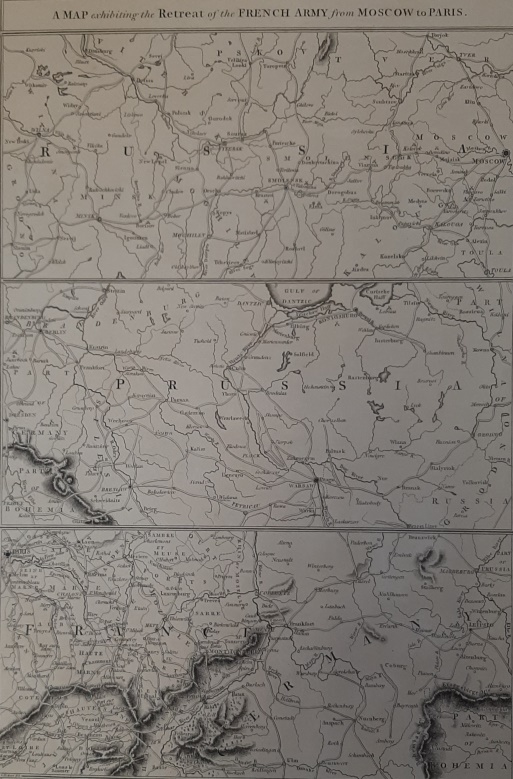
No. 73
73. BOWYER, Robert [1758-1834] (Publisher). MILTON, W. (Engraver). A Map exhibiting the Retreat of the French Army from Moscow to Paris. 18 5/8 x 12 7/8 inches (47.3 x 32.7 cm., entire sheet). engraving. (marginal tear & chipped corners). London: 20 Feb., 1815. $125
Published in Robert Bowyer’s ‘The Triumphs of Europe in the Campaigns of the Years 1812, 1813, 1814’/‘Illustrated Record of Important Events in the Annals of Europe, during the years 1812, 1813, 1814 & 1815’, London: 1814-15.
Abbey, ‘Life in England’, 352.
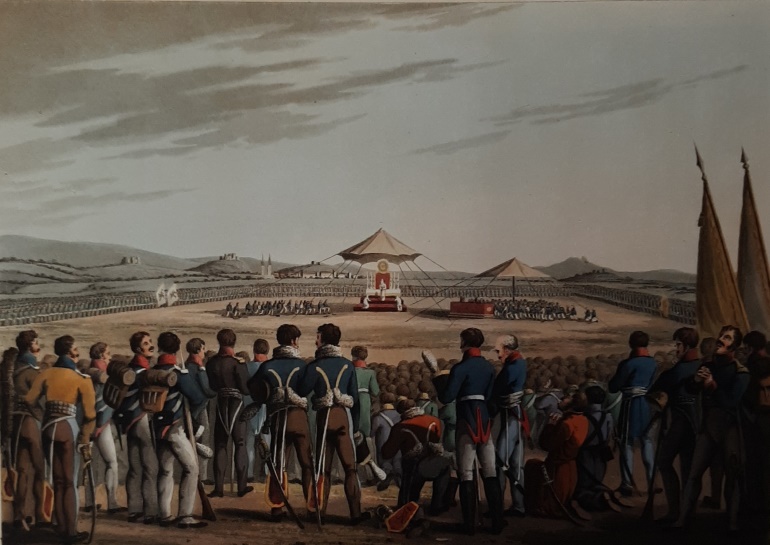
No. 74
74. CLARK, John Heaviside [1771-1863] (After). DUBOURG, Matthew (Engraver). The Grand Te Deum On The Field Of Battle Near Toplitz. Attended by the Allied Sovereigns & Troops 1813. 10 ¾ x 13 3/4 inches (27.3 x 34.9 cm., entire street). hand-coloured aquatint. London: Edward Orme, April 1st 1816. $175
At the Battle of Teplitz (Toplitz) or Second Battle of Kulm in northern Bohemia, 17 September 1813, the French army commanded by Napoleon was defeated by the Coalition forces of Prussia, Russia, and Austria commanded by the Austrian Field Marshal, Prince of Schwarzenberg. Published in Edward Orme’s ‘Historic, Military, and Naval Anecdotes’, London: 1819.
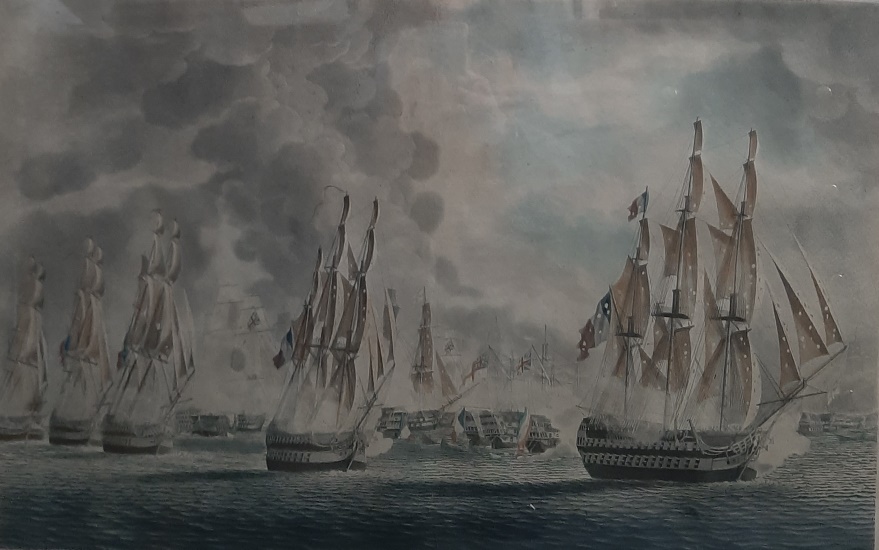
No. 75
75. DODD, Robert [1748-1815] (After). Battle of Trafalgar 1805. Comprising: 'Battle of Trafalgar, Van Division', 'Battle of Trafalgar, Rear Division', Victory at Trafalgar, in the Van', 'Battle of Trafalgar, in the Rear'. 30 x 20 inches (76 x 51 cm., plate). 4 hand-coloured aquatints. London: J.W.Laird, 1843. $6,000
In one of the most famous and decisive naval battles in history, a British fleet under Admiral Lord Horatio Nelson defeated a combined French and Spanish fleet at the Battle of Trafalgar off the coast of Spain on October 21, 1805, thereby ensuring the safety of Britain from invasion and the preservation of British supremacy at sea. While the allies lost a total of 22 ships the Royal Navy lost none. Departing from naval tactical orthodoxy, Nelson sailed his ships in two columns directly at the enemy’s battle line flank, splitting its fleet into three, and trusting his better trained crews and faster heavier guns to achieve victory in the ensuing melee. Nelson himself died on board the ‘Victory’, having sustained bullet wounds to the shoulder and chest. Hailed as the nation’s savior he was given a spectacular funeral in St. Paul’s Cathedral, and numerous monuments and memorials were erected in his honour.
Dodd was a marine painter and aquatint engraver, best known for his works on the French Revolutionary Wars.
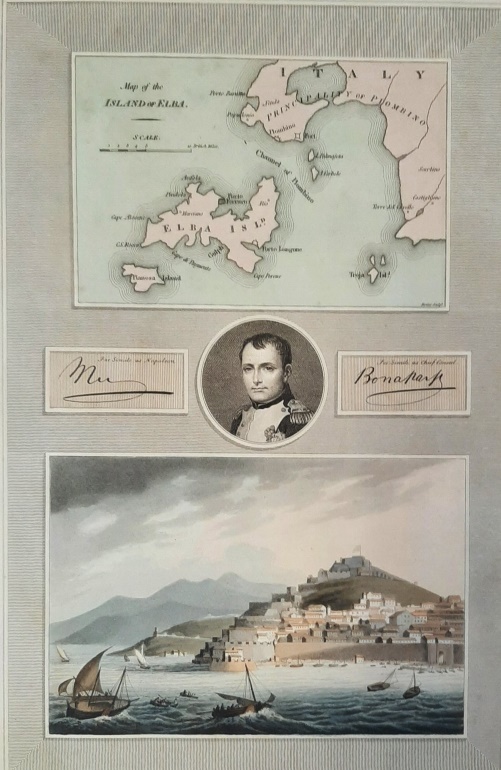
No. 76
76. (ELBA - EXILE). BOWYER, Robert [1758-1834] (Publisher). Porto Ferrajo. hand-coloured aquatint view of Porto Ferrajo on Elba (12.4 x 18.5 cm.) (lower image). engraved portrait roundel of Napoleon, 5.6 cm. in diameter, to either side facsimiles of Napoleon’s signatures as Napoleon & as Chief Consul (centre). hand-coloured engraved map of the Island of Elba (10.5 x 16. 3 cm.) by Davies (upper image). 18 1/2 x 12 7/8 inches (47 x 32.7 cm., entire sheet). engraving & aquatint (few chips to margins). London: 1815. $150
The French Emperor Napoleon was exiled to Elba, after his forced abdication following the Treaty of Fontainebleau. He arrived at Portoferraio on 4 May 1814, where he was allowed to keep a personal guard of 600 men and was nominally sovereign of Elba. After staying for almost ten months, he escaped to France on 26 February 1815. Published in Robert Bowyer’s ‘The Triumphs of Europe in the Campaigns of the Years 1812, 1813, 1814’/‘Illustrated Record of Important Events in the Annals of Europe, during the years 1812, 1813, 1814 & 1815’, London: 1814-15.
Abbey, ‘Life in England’, 352.
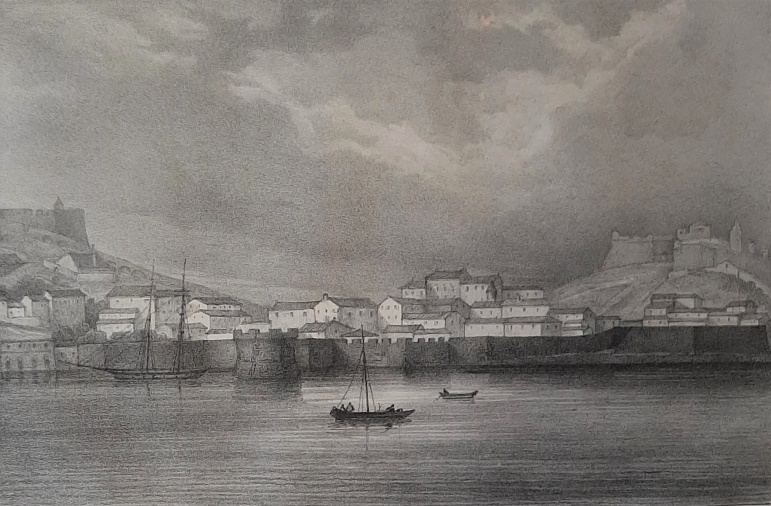
No. 77
77. (ELBA - EXILE). OUVRIÉ, Pierre Justin [1806-1879]. ENGELMANN, Godfroy [1788-1839] (Lithographer). Maison de ville de Napoléon (Lettre N.) à Porto-Ferayo, Île d’Elbe. 7 x 13 inches (17.8 x 33 cm.). 13 x 21 inches (33.7 x 53.3 cm., full sheet). lithograph on India paper, mounted on larger sheet (light foxing to margins). [Paris: c1830]. $500
Ouvrié was a painter of architecture, monuments and landscapes world wide. Often under commission, Ouvrié was regularly exhibited in the Salons which won him a few medals. On December 30, 1854 he received the prestigious title of Chevalier de la Légion d’Honneur.

No. 78
78. (ELBA - EXILE). OUVRIÉ, Pierre Justin [1806-1879] (After). ENGELMANN, Godfroy [1788-1839] (Lithographer). Maison de campagne de Napoléon, (Lettre N.) Vallée de St. Martin à l’île d’Elbe, & Chaumière du Gal. Drouout, (Lettre D.). 7 x 13 inches (17.8 x 33 cm.). 14 x 21 inches (35.6 x 53.3 cm., full sheet). lithograph on India paper, mounted on larger sheet (light foxing to margins). [Paris: c1830]. $500

No. 79
79. HEATH, W[illiam] [1794-1840] (After). DUBOURG, Matthew (Engraver). Anecdote At The Battle Of Trafalgar. 10 ½ x 13 5/8 inches (26.7 x 34.6 cm., entire sheet). hand-coloured aquatint. London: Edward Orme, June 4th, 1817. $175
Naval officers and sailors in a boat are shown rescuing a woman from drowning. Battling ships are show in the background. In Nelson’s time women frequently accompanied their husbands to sea. Published in Edward Orme’s ‘Historic, Military, and Naval Anecdotes’, London: 1819.
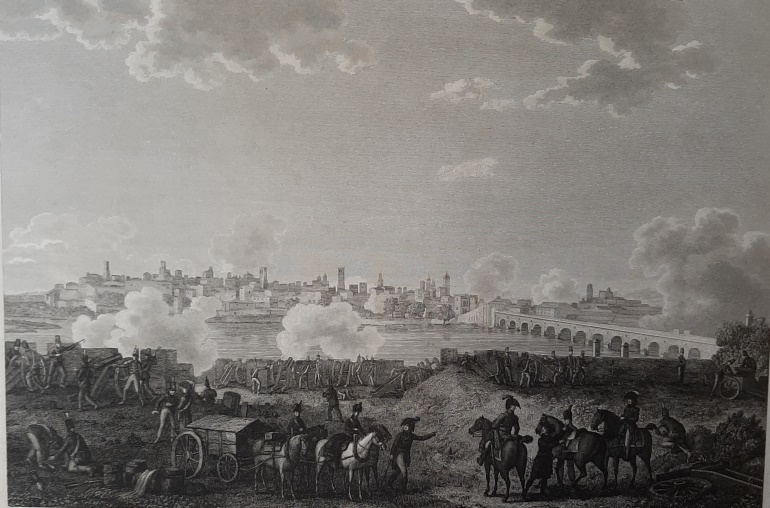
No. 80
80. L’ÉVÊQUE, Henri [1769-1832] (Artist & Engraver). The Siege of Badajos. marked ‘Proof’. ('Campaigns of the British Army in Portugal', Plate 15). 16 x 22 3/8 inches (40.6 x 56.8 cm., entire sheet). etching & engraving (some foxing to margins & title area). London: Colnaghi & Co., May 1815. $925
In the siege of Badajoz, March 16-April 6, 1812, also called the third siege of Badajoz, an Anglo-Portuguese Army under Wellington’s command besieged the Spanish fortress on the southwestern border of Portugal, and forced the surrender of the French garrison of some 5,000 French soldiers under General Armand Philippon. The siege was one of the bloodiest in the Napoleonic Wars and was considered a costly victory by the British, with some 4,800 Allied soldiers killed or wounded.
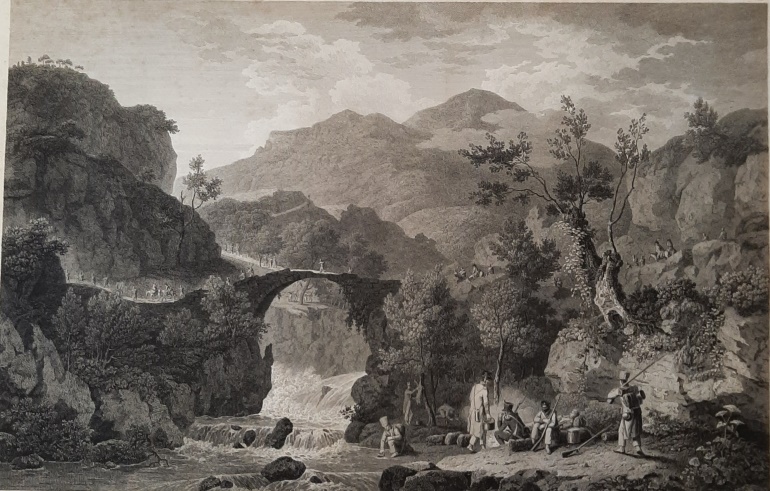
No. 81
81. L’ÉVÊQUE, Henri [1769-1832] (After). COMTE, Benjamin Rodolphe [c1760-1851]. (Engraver). A View Of The Bridge Of Miserere, About Three Leagues From Salamonde. The French are here seen worn down with fatigue, retreating towards the Spanish Frontier. ('Campaigns of the British Army in Portugal', Plate 11). 16 x 22 3/8 inches (40.6 x 56.8 cm., entire sheet). etching & engraving (some foxing). London: Colnaghi & Co., Jan. 1, 1813. $700
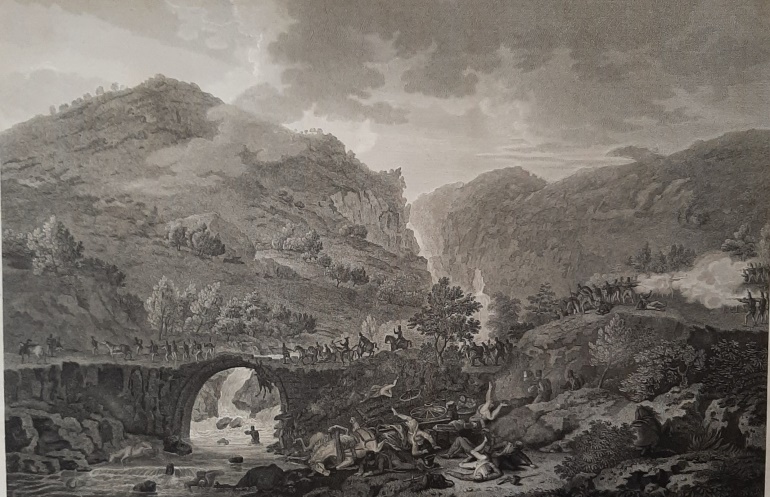
No. 82
82. L’ÉVÊQUE, Henri [1769-1832] (After). FITTLER, James [1758-1835]. (Engraver). The Bridge Of Saltador where the pursuit after the success at Salamonde terminated. ('Campaigns of the British Army in Portugal', Plate 10). 16 x 22 3/8 inches (40.6 x 56.8 cm., entire sheet). etching & engraving (some foxing to margins & title area, 1 short marginal tear). London: Colnaghi & Co., April 2, 1812. $700
The bridge spans a ravine in foreground-left, set against a mountainous backdrop. Numerous fallen soldiers and horses are shown including a fallen horse and cart in the foreground-centre. British troops attack the retreating French, centre-right.
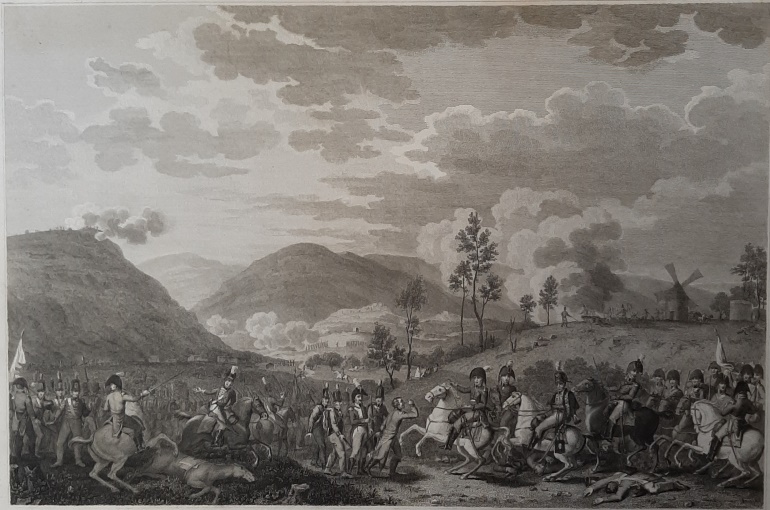
No. 83
83. L’ÉVÊQUE, Henri [1769-1832] (After). FITTLER, James [1758-1835]. (Engraver). Passage Of The Douro by the Division under the Command of Lt. Genl. the Honble. Edward Paget. ('Campaigns of the British Army in Portugal', Plate 6). 16 x 22 3/8 inches (40.6 x 56.8 cm., entire sheet). etching & engraving (some foxing to margins & title area). London: Colnaghi & Co., April 2, 1812. $925
In the Second Battle of Porto, also known as the Battle of the Douro or the Crossing of the Douro, May 12, 1809, General Arthur Wellesley’s Anglo-Portuguese army defeated Marshal Nicolas Soult’s French troops and took back the city of Porto. The battle ended the second French invasion of Portugal. Second-in-command, Edward Paget, lost his right arm in the battle.
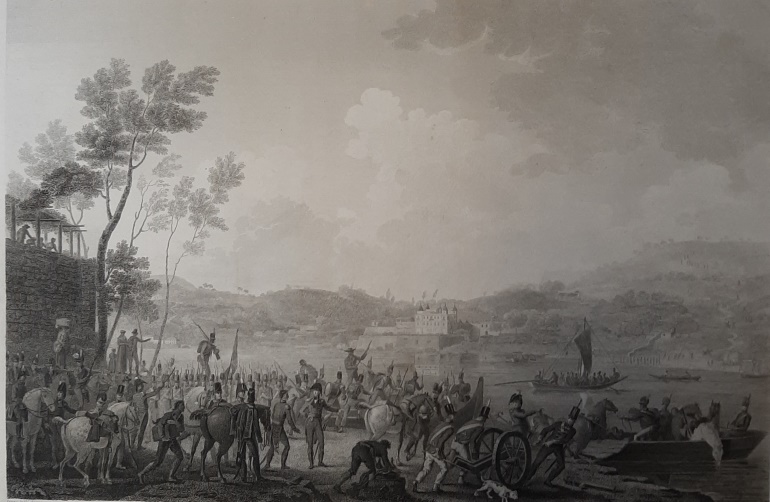
No. 84
84. L’ÉVÊQUE, Henri [1769-1832] (After). HEATH, Charles [1785-1848]. (Engraver). Passage Of The Douro, by the Division under the Command of Lt. Genl. Sir John Murray. ('Campaigns of the British Army in Portugal', Plate 7). 16 x 22 3/8 inches (40.6 x 56.8 cm., entire sheet). etching & engraving (some foxing to margins, tear in left margin). London: Colnaghi & Co., April 2, 1812. $925
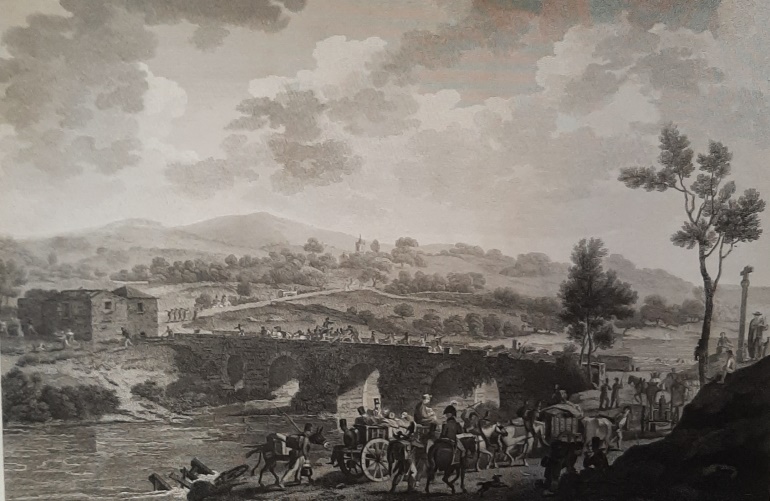
No. 85
85. L’ÉVÊQUE, Henri [1769-1832] (After). HEATH, Charles [1785-1848]. (Engraver). Bridge Of Nodin, where the French are represented throwing the last of their Cannon into the river Dave. ('Campaigns of the British Army in Portugal', Plate 8). 16 x 22 3/8 inches (40.6 x 56.8 cm., entire sheet). etching & engraving (some foxing to margins & title area, tear & small hole in margin). London: Colnaghi & Co., April 2, 1812. $725
The print shows the French army in flight, with a column of ambulance and baggage wagons approaching the bridge from which a cannon is thrown into the river.
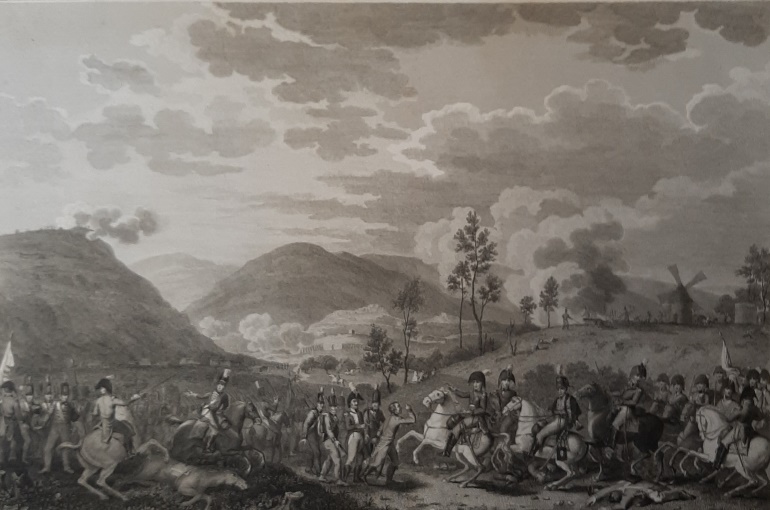
No. 86
86. L’ÉVÊQUE, Henri [1769-1832] (After). VENDRAMINI, Giovanni [1769-1839] (Engraver). The Attack Of The French Corps Commanded by Genl. Laborde, On The 17th Of Augt. 1808. ('Campaigns of the British Army in Portugal', Plate 2). 16 x 22 3/8 inches (40.6 x 56.8 cm., entire sheet). etching & engraving (some foxing to margins & title area, tear & small hole in margin). London: Colnaghi & Co., Jan. 1, 1813. $800
In the Battle of Roliça, Portugal (17 August 17, 1808), an Anglo-Portuguese army under Sir Arthur Wellesley defeated an outnumbered Imperial French division under General of Division Henri François Delaborde. This was the first battle fought by the British army during the Peninsular War.
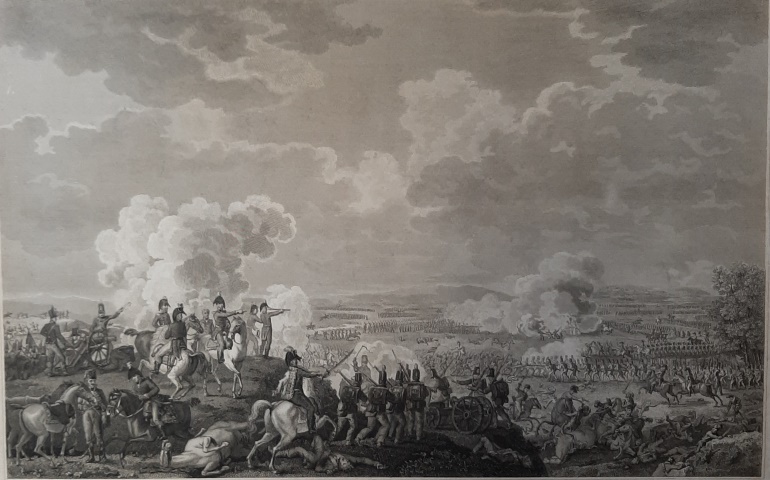
No. 87
87. L’ÉVÊQUE, Henri [1769-1832] (After). VENDRAMINI, Giovanni [1769-1839]. (Engraver). The Battle of Talavera. ('Campaigns of the British Army in Portugal', Plate 12). 16 x 22 3/8 inches (40.6 x 56.8 cm., entire sheet). etching & engraving (some spotting to margins & title area, marginal defect at top margin). London: Colnaghi & Co., Jan. 1, 1813. $925
In the Battle of Talavera, July 27-28, 1809, an Imperial French army under King Joseph Bonaparte and Marshal Jean-Baptiste Jourdan attacked an Anglo-Spanish army led by Sir Arthur Wellesley. After several of their assaults were bloodily repulsed on the second day, the French retreated toward Madrid. Wellesley was ennobled as Viscount Wellington of Talavera and of Wellington for the engagement.
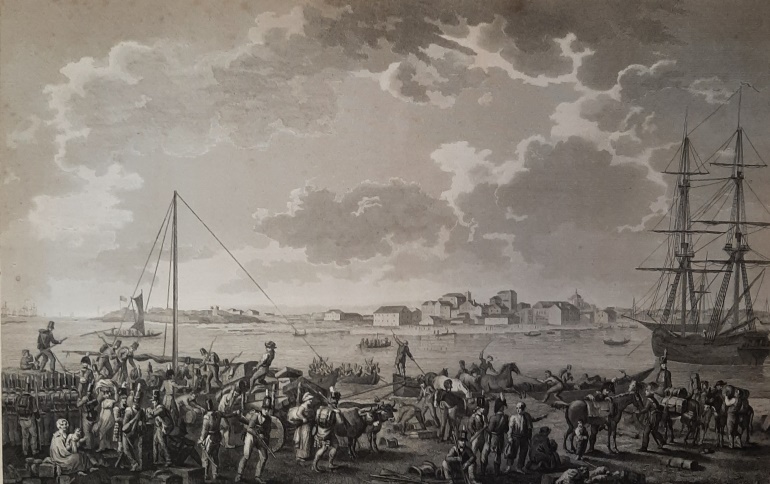
No. 88
88. L’ÉVÊQUE, Henri [1769-1832] (After). VENDRAMINI, Giovanni [1769-1839] (Engraver). The Landing Of The British Army At Mondego Bay. ('Campaigns of the British Army in Portugal', Plate 1). 16 x 22 3/8 inches (40.6 x 56.8 cm., entire sheet). etching & engraving (some foxing to margins & title area, marginal tear). London: Colnaghi & Co., April 2, ,1812. $825
A British force of around 14,000 men commanded by Sir Arthur Wellesley landed at Mondego Bay, about 100 miles north of Lisbon, during the first week of August 1808. On 17 August they fought their first battle of the Peninsular War (1808-1814) at Rolica, defeating a smaller French force under General Henri Delaborde that had been sent to slow Wellesley's advance towards Lisbon.
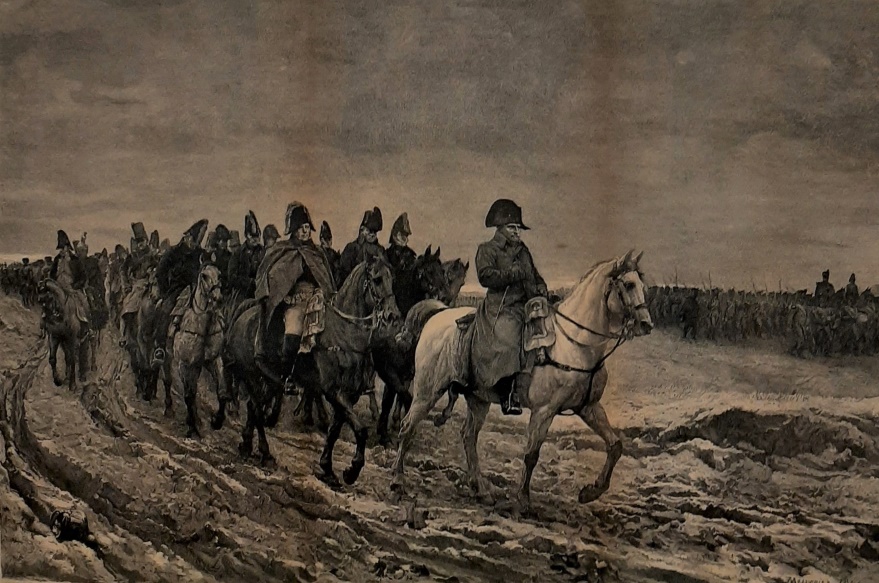
No. 89
89. MEISSONIER, Jean Louis Ernest [1815-1891] (Artist). JACQUET, Jules [1841-1913] (Engraver). 1814 [Napoleon and his Staff returning from Soissons after the Battle of Laon]. 16 x 24 ¼ inches (40.6 x 61.4 cm., size of image). engraving. New York: Wellstood, Leggo & Co., [c1884]. $1,000
At the Battle of Laon in Northern France (March 9-10), 1814) Napoleon’s army was defeated by von Blücher's Prussian forces. Meissonier was famous for his paintings of Napoleon and his armies and military themes. Napoleon Bonaparte is shown astride a white horse at the head of his war-weary troops, retreating towards Soissons after the defeat.
VERNET, Carle Et Al. Campagnes des Français Sous Le Consulat & L’Empire. Paris: [c1840]. The following 14 prints are from this series. They are arranged in chronological order by battle. We have others in stock and invite inquiries.

No. 90
90. (1797 RIVOLI). VERNET, Carle [1758-1836] (After). DUPLESSIS-BERTAUX, Jean [1747-1820] & Jean-Louis DELIGNON [1755-c1804] (Engravers). Bataille De Rivoli, Les 25 Et 26 Nivose An 5. (from ‘Campagnes des Français Sous Le Consulat & L’Empire’). 12 ¼ x 18 3/8 inches (31.1 x 46.7 cm., entire sheet). etching & engraving (6 small holes in upper blank margin). [Paris: c1840]. $175
“The Battle of Rivoli (14–15 January 1797) was a key victory in the French campaign in Italy against Austria. Napoleon Bonaparte's 23,000 Frenchmen defeated an attack of 28,000 Austrians under General of the Artillery Jozsef Alvinczi, ending Austria's fourth and final attempt to relieve the siege of Mantua. Rivoli further demonstrated Napoleon's brilliance as a military commander and led to the French consolidation of northern Italy.” (Wikipedia)
Vernet won acclaim for his detailed battle scenes glorifying Napoleon, and for one of his works, ‘Morning of Austerlitz’, he was awarded the Legion of Honour by Napoleon and the Order of St. Michael by Louis XVIII.
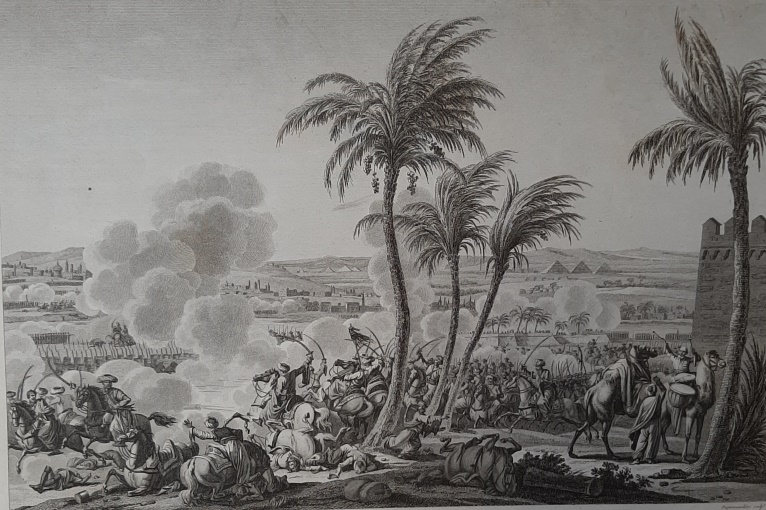
No. 91
91. (1798 CAIRO). SWEBACH-DESFONTAINES, Jacques François Joseph [1769-1823] (After). COUCHÉ, François Louis [1782-1849] & François DEQUEVAUVILERS [1749-1807] (Engravers). Bataille Du Caire, Dite Des Pyramides, Livrée Le 3 Thermidor An 6. (21 Juillet 1798). (from ‘Campagnes des Français Sous Le Consulat & L’Empire’). 12 ¼ x 18 3/8 inches (31.1 x 46.7 cm., entire sheet). etching & engraving (6 small holes in upper blank margin). [Paris: c1840]. $175
“The Battle of the Pyramids, also known as the Battle of Embabeh, was a major engagement fought on 21 July 1798, during the French Invasion of Egypt…After capturing Alexandria and crossing the desert, the French army led by General Napoleon Bonaparte, scored a decisive victory against the main army of the local Mamluk rulers, wiping out almost the entire Ottoman army located in Egypt. It was the first battle where Napoleon personally devised and employed the divisional square tactic to great effect. The deployment of the French brigades into these massive rectangular formations repeatedly threw back multiple cavalry charges of the Mamluks.” (Wikipedia)
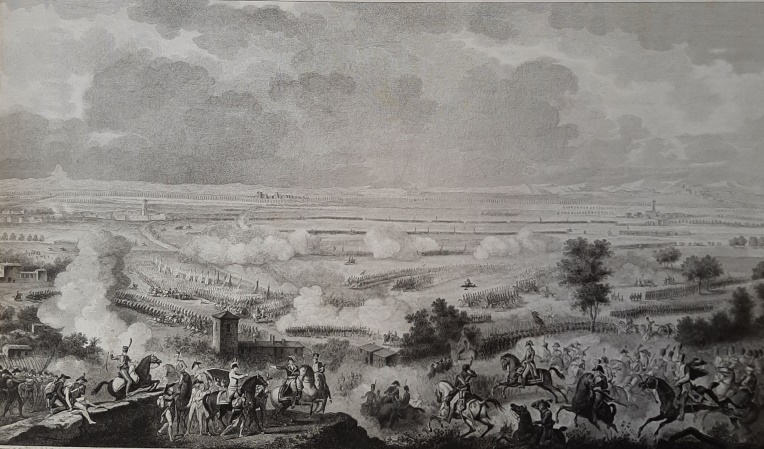
No. 92
92. (1800 MARENGO). VERNET, Carle [1758-1836] (After). DUPLESSIS-BERTAUX, Jean [1747-1820] & Nicolas PONCE [1746-1831] (Engravers). Bataille De Marengo, Livrée Le 23 Prairial An 8, (12 Juin 1800.) from ‘Campagnes des Français Sous Le Consulat & L’Empire’). 12 ¼ x 18 3/8 inches (31.1 x 46.7 cm., entire sheet). etching & engraving (6 small holes in upper blank margin). [Paris: c1840]. $175
“The Battle of Marengo was fought on 14 June 1800 between French forces under the First Consul Napoleon Bonaparte and Austrian forces near the city of Alessandria, in Piedmont, Italy. Near the end of the day, the French overcame Gen. Michael von Melas's surprise attack, driving the Austrians out of Italy and consolidating Napoleon's political position in Paris as First Consul of France in the wake of his coup d’état the previous November.” (Wikipedia)
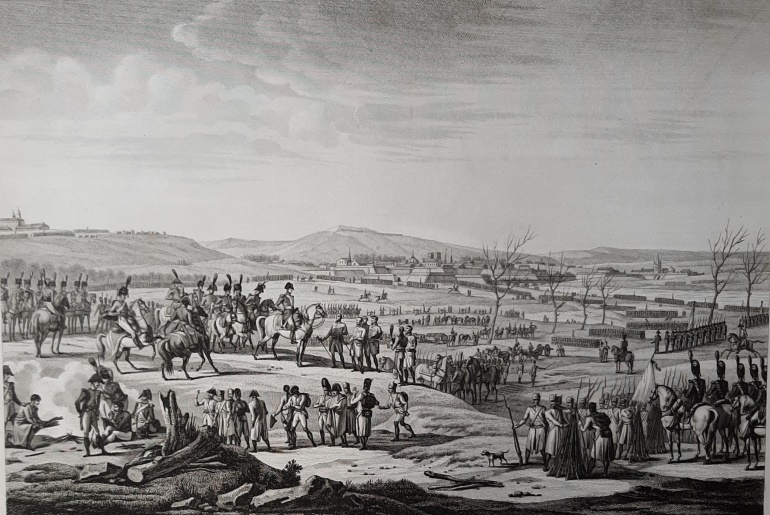
No. 93
93. (1805 ULM). SWEBACH-DESFONTAINES, Jacques François Joseph [1769-1823] (After). COUCHÉ, François Louis [1782-1849] & François PIGEOT [1775-1834] (Engravers). Prise D’Ulm, Le 17 Octobre 1805. (from ‘Campagnes des Français Sous Le Consulat & L’Empire’). 12 ¼ x 18 3/8 inches (31.1 x 46.7 cm., entire sheet). etching & engraving (6 small holes in upper blank margin). [Paris: c1840]. $175
The Battle of Ulm on 16–19 October 1805 was a series of skirmishes, at the end of the Ulm Campaign, which allowed Napoleon I to trap an entire Austrian army under the command of Karl Freiherr Mack von Leiberich with minimal losses and to force its surrender near Ulm in the Electorate of Bavaria.
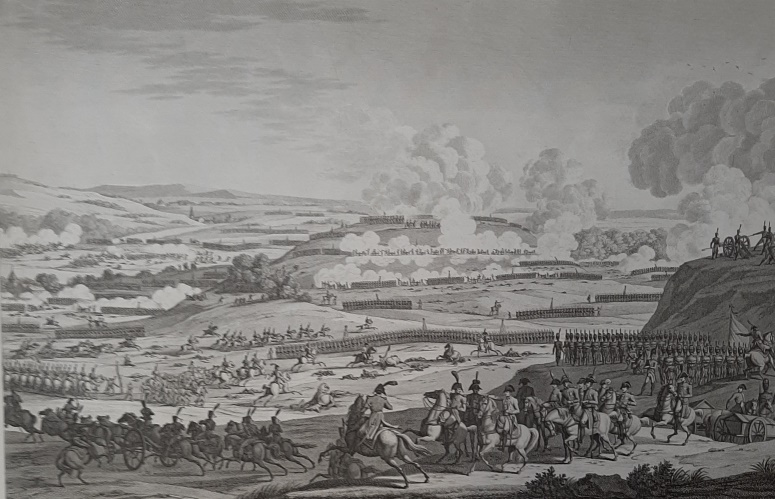
No. 94
94. (1806 JENA). SWEBACH-DESFONTAINES, Jacques François Joseph [1769-1823] (After). COUCHÉ, François Louis [1782-1849] & Edme BOVINET [1767-c1832] (Engravers). Bataille D’Jena, Livree Le 14 Octobre 1806. (from ‘Campagnes des Français Sous Le Consulat & L’Empire’). 12 ¼ x 18 3/8 inches (31.1 x 46.7 cm., entire sheet). etching & engraving (6 small holes in upper blank margin). [Paris: c1840]. $175
“The twin battles of Jena and Auerstedt were fought on 14 October 1806 on the plateau west of the river Saale in today's Germany, between the forces of Napoleon I of France and Frederick William III of Prussia. The decisive defeat suffered by the Prussian Army subjugated the Kingdom of Prussia to the French Empire until the Sixth Coalition was formed in 1813.” (Wikipedia)

No. 95
95. (1807 DANZIG). SWEBACH-DESFONTAINES, Jacques François Joseph [1769-1823] (After). COUCHÉ, François Louis [1782-1849] & François dequevauvillers [1745-1807] (Engravers). Napoléon Visite Les Travaux Du Siège De Dantzick, Dirigés Par Le Maréchal Lefebvre, Le 9 Mai 1807. from ‘Campagnes des Français Sous Le Consulat & L’Empire’). 12 ¼ x 18 3/8 inches (31.1 x 46.7 cm., entire sheet). etching & engraving (6 small holes in upper blank margin, some light foxing). [Paris: c1840]. $175
The siege of Danzig (19 March – 24 May 1807) was the French encirclement and capture of Danzig, a strategic and heavily fortified port at the mouth of the Vistula, during the War of the Fourth Coalition. On 19 March 1807, around 27,000 French troops under Marshal Lefebvre besieged around 14,400 Prussian troops under Marshal Kalckreuth garrisoning the city of Danzig.

No. 96
96. (1807 FRIEDLAND). SWEBACH-DESFONTAINES, Jacques François Joseph [1769-1823] (After). COUCHÉ, François Louis [1782-1849] & François PIGEOT [1775-1834] (Engravers). Bataille De Friedland, Livrée Le 14 Juin 1807. (from ‘Campagnes des Français Sous Le Consulat & L’Empire’). 12 ¼ x 18 3/8 inches (31.1 x 46.7 cm., entire sheet). etching & engraving (6 small holes in upper blank margin). [Paris: c1840]. $175
“The Battle of Friedland (14 June 1807) was a major engagement of the Napoleonic Wars between the armies of the French Empire commanded by Napoleon I and the armies of the Russian Empire led by Count von Bennigsen. Napoleon and the French obtained a decisive victory that routed much of the Russian army, which retreated chaotically over the Alle River by the end of the fighting. The battlefield is located in modern-day Kaliningrad Oblast, near the town of Pravdinsk, Russia….Napoleon's overwhelming victory…effectively ended the War of the Fourth Coalition, as Emperor Alexander I reluctantly entered peace negotiations with Napoleon. These discussions eventually culminated in the Treaties of Tilsit, by which Russia agreed to join the Continental System against Great Britain and by which Prussia lost almost half of its territories.” (Wikipedia)
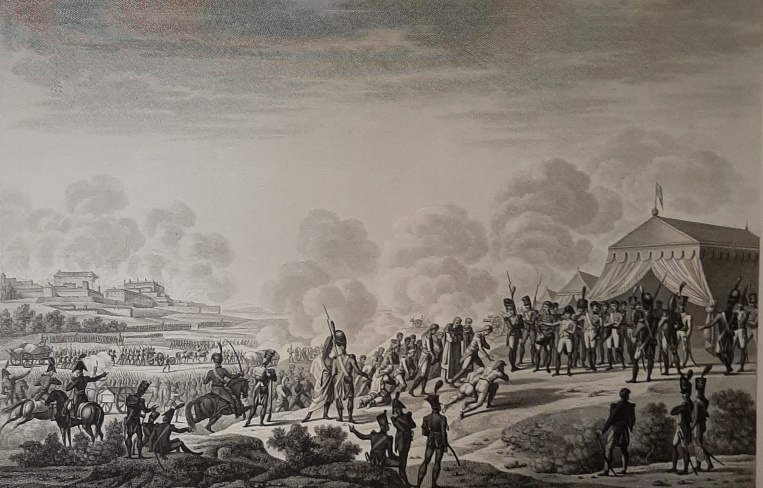
No, 97
97. (1808 MADRID). LE COMTE, Hippolyte [1781-1857] (After). COUCHÉ, François Louis [1782-1849] & Edme BOVINET [1767-c1832] (Engravers). Bombardement De Madrid, Le 4 Décembre 1808. (from ‘Campagnes des Français Sous Le Consulat & L’Empire’). 12 ¼ x 18 3/8 inches (31.1 x 46.7 cm., entire sheet). etching & engraving (6 small holes in upper blank margin). [Paris: c1840]. $175
The siege of Madrid, December 1-4, 1808 was the final French success during Napoleon’s only campaign in Spain. Napoleon made two offers for peaceful surrender that were not accepted. After heavy bombardment of the city on December 3 the Spanish capitulated the next day. Napoleon planned for his brother Joseph to resume the governance of the city, but other events across Europe forced the emperor to leave Spain following the siege.
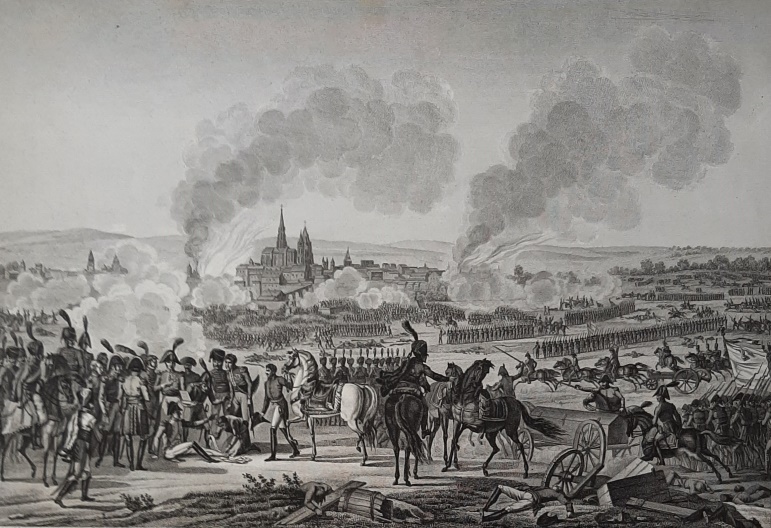
No. 98
98. (1809 RATISBON). ROEHN, Adolphe [1780-1867] (After). COUCHÉ, François Louis [1782-1849] & François PIGEOT [1775-1834] (Engravers). Bataille De Ratisbonne, Livrée Le 23 Avril 1809. (from ‘Campagnes des Français Sous Le Consulat & L’Empire’). 12 ¼ x 18 3/8 inches (31.1 x 46.7 cm., entire sheet). etching & engraving (6 small holes in upper blank margin). [Paris: c1840]. $175
“The Battle of Ratisbon, also called the Battle of Regensburg, was fought on 23 April 1809, during the Napoleonic Wars, between the army of the First French Empire, led by Napoleon I, and that of the Austrian Empire, led by Archduke Charles. Scene of the last engagement of the Bavaria phase of the campaign of 1809, the brief defense of the city and installation of a pontoon bridge to the east enabled the retreating Austrian army to escape into Bohemia.” (Wikipedia) Napoleon was wounded in his ankle by a small artillery round during the engagement.
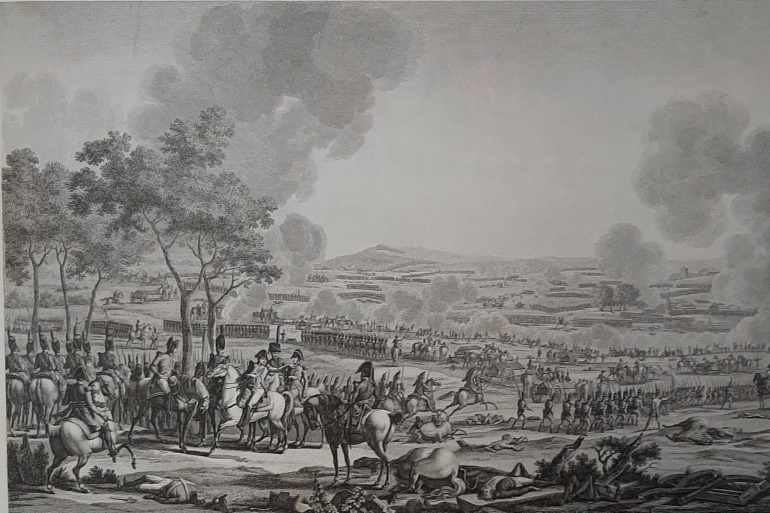
No. 99
99. (1809 WAGRAM). SWEBACH-DESFONTAINES, Jacques François Joseph [1769-1823] (After). COUCHÉ, François Louis [1782-1849] & MARIAGE (Engravers). Bataille De Wagram, Livrée Le 7 Juillet 1809. (from ‘Campagnes des Français Sous Le Consulat & L’Empire’). 12 ¼ x 18 3/8 inches (31.1 x 46.7 cm., entire sheet). etching & engraving (6 small holes in upper blank margin). [Paris: c1840]. $175
At the Battle of Wagram (5–6 July 1809) Napoleon's French and allied army won a decisive but costly victory against the Austrian army under the command of Archduke Charles of Austria-Teschen. The battle led to the breakup of the Fifth Coalition, the Austrian and British-led alliance against France. “With more than 300,000 combatants, Wagram was the largest battle in European history up to its time. With at least 72,000 casualties on both sides, it was also the bloodiest military engagement of the entire Revolutionary and Napoleonic Wars thus far. The unusually high casualty rate was due mainly to an unprecedented concentration of artillery, on a flat battlefield, where the deadly roundshot – each army fired at least 90,000 during the two days of battle – was most effective.” (Wikipedia)

No. 100
100. (1809 OCAÑA). ROEHN, Adolphe [1780-1867] (After). COUCHÉ, François Louis [1782-1849] & François PIGEOT [1775-1834] (Engravers). Bataille D’Ocanna, Livré Le 19 Novembre 1809. (from ‘Campagnes des Français Sous Le Consulat & L’Empire’). 12 ¼ x 18 3/8 inches (31.1 x 46.7 cm., entire sheet). etching & engraving (6 small holes in upper blank margin). [Paris: c1840]. $175
“The Battle of Ocaña was fought on 19 November 1809 between French forces under Marshal Jean de Dieu Soult, Duke of Dalmatia and King Joseph Bonaparte and the Spanish army under Juan Carlos de Aréizaga, which suffered its greatest single defeat in the Peninsular War. General Juan Carlos de Aréizaga's Spanish army of 51,000 lost nearly 19,000 killed, wounded, prisoners and deserters, mostly due to the French use of their cavalry. Tactically, the battle was a Cannae-like encirclement of the Spanish army, and the worst defeat ever suffered by a Spanish army on home soil. The strategic consequences were also devastating, as it destroyed the only force capable of defending southern Spain; the area was overrun over the winter in the Andalusia campaign.” (Wikipedia)
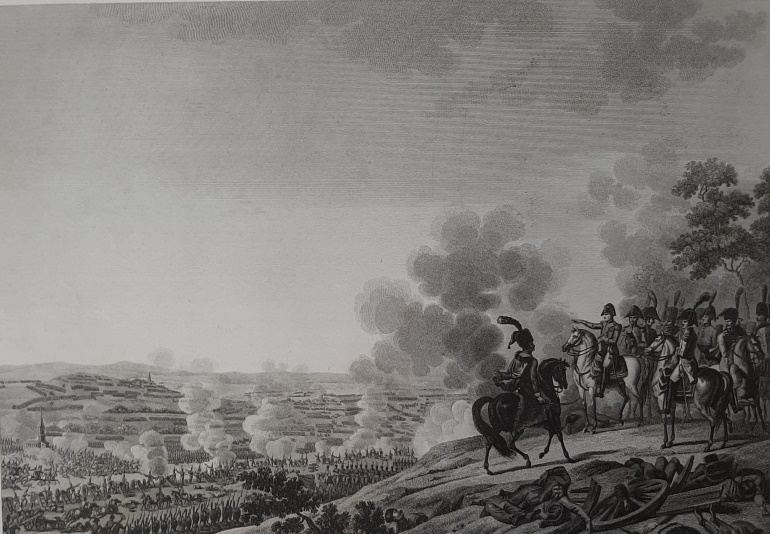
No. 101
101. (1812 BORODINO). ROEHN, Adolphe [1780-1867] (After). COUCHÉ, François Louis [1782-1849] & Jacques COUCHÉ [1750-1836] (Engravers). Bataille De La Moskowa, Livrée Le 7 Septembre 1812. (from ‘Campagnes des Français Sous Le Consulat & L’Empire’). 12 ¼ x 18 3/8 inches (31.1 x 46.7 cm., entire sheet). etching & engraving (6 small holes in upper blank margin). [Paris: c1840]. $175
“The Battle of Borodino took place near the village of Borodino on 7 September 1812 during Napoleon's French invasion of Russia. The Grande Armée won the battle against the Imperial Russian Army with casualties in a ratio 2:3, but failed to gain a decisive victory. Napoleon fought against General Mikhail Kutuzov, whom the Emperor Alexander I of Russia had appointed to replace Barclay de Tolly on 29 August 1812 after the Battle of Smolensk.” (Wikipedia) Napoleon went on to occupy Moscow where he remained for five weeks awaiting a surrender that would never come before deciding to retreat. Napoleon had begun his disastrous campaign with almost half a million men, but only about 10,000 soldiers made it out of Russia alive, the others lost to casualties, disease, starvation and severe weather conditions. The invasion is “one of the best studied military campaigns in history and is listed among the most lethal military operations in world history. It is characterized by the massive toll on human life.” (Wikipedia)
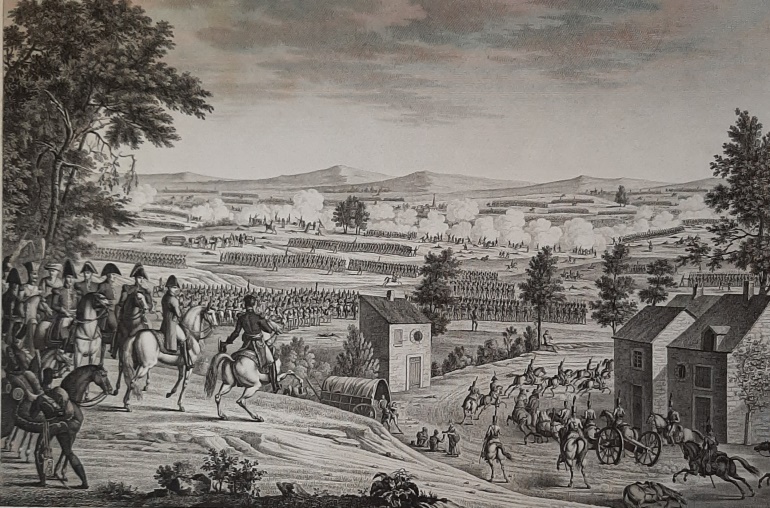
No. 102
102. (1813 LÜTZEN). COUCHÉ, François Louis [1782-1849] & Edme BOVINET [1767-c1832] (Engravers). Bataille De Lutzen, Livrée Le 2 Mai 1813. (from ‘Campagnes des Français Sous Le Consulat & L’Empire’). 12 ¼ x 18 3/8 inches (31.1 x 46.7 cm., entire sheet). etching & engraving (6 small holes in upper blank margin). [Paris: c1840]. $175
“In the Battle of Lützen (2 May 1813), Napoleon I of France halted the advances of the Sixth Coalition after the French invasion of Russia and the massive French losses in the campaign. The Russian commander, Prince Peter Wittgenstein, attempting to forestall Napoleon's capture of Leipzig, attacked the French right wing near Lützen, Saxony-Anhalt, Germany. After a day of heavy fighting, the combined Prussian and Russian force retreated; due to French losses and a shortage of French cavalry, Napoleon was unable to conduct a pursuit.” (Wikipedia)
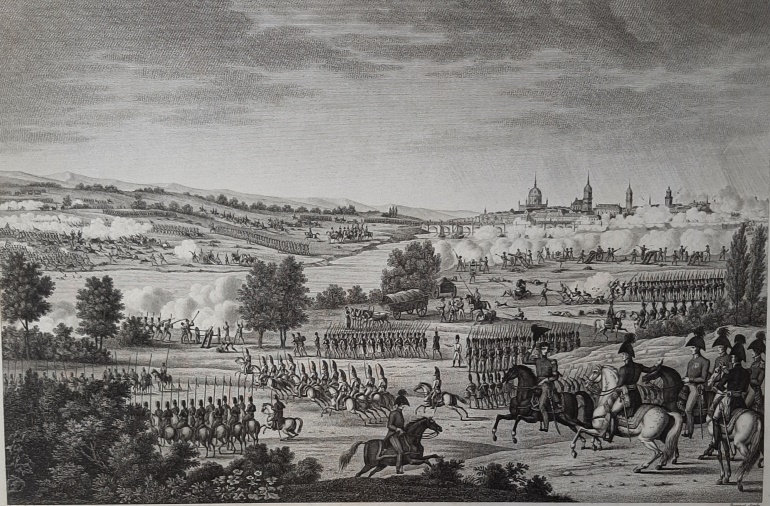
No. 103
103. (1813 DRESDEN). COUCHÉ, François Louis [1782-1849] & Edme BOVINET [1767-c1832] (Engravers). Bataille De Dresde, Livrée Le 26 Août 1813. (from ‘Campagnes des Français Sous Le Consulat & L’Empire’). 12 ¼ x 18 3/8 inches (31.1 x 46.7 cm., entire sheet). etching & engraving (6 small holes in upper blank margin). [Paris: c1840]. $175
At the Battle of Dresden (26–27 August 1813) Napoleon defeated the Army of Bohemia led by Generalissimo Karl von Schwarzenberg despite being heavily outnumbered.
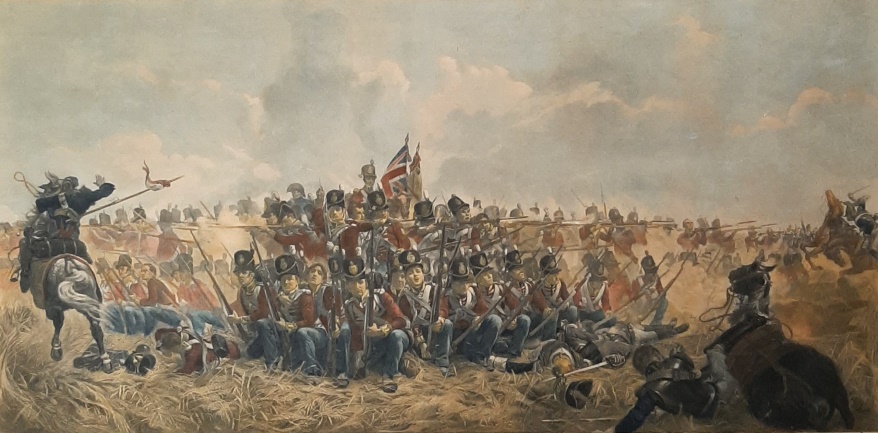
No. 104
104. (WATERLOO CAMPAIGN). THOMPSON, Elizabeth, Lady BUTLER [1846-1933] (After). Quatre-Bras, The afternoon of June 16th 1815. 15 ¾ x 26 ½ inches (40 x 67.3 cm.), entire sheet). photogravure with later hand-colour. matted. London: The Fine Art Society, [c1890]. $800
“The Battle of Quatre Bras was fought on 16 June 1815, as a preliminary engagement to the decisive Battle of Waterloo that occurred two days later. The battle took place near the strategic crossroads of Quatre Bras and was contested between elements of the Duke of Wellington's Anglo-allied army and the left wing of Napoleon Bonaparte's French Armée du Nord under Marshal Michel Ney. While the battle was a coalition victory, Napoleon prevented Wellington's forces from aiding the Prussian army at the Battle of Ligny, which the French won the same day.” (Wikipedia)
“Thompson based the painting on the account of the battle in a book written by Captain William Siborne, the History of the War in France and Belgium in 1815, first published in 1844. The painting portrays the 28th (North Gloucestershire) Regiment of Foot, of the British Army, on 16 June 1815, at the Battle of Quatre Bras. The battle, part of the Waterloo Campaign of the Hundred Days, was just two days prior to the Battle of Waterloo. The regiment held off attacks from French cavalry at Quatre Bras. Thompson shows the regiment formed in a square in a field of rye, withstanding attacks, at approximately 17:00, from lancers and cuirassiers led by Marshal Ney.” (Ibid)
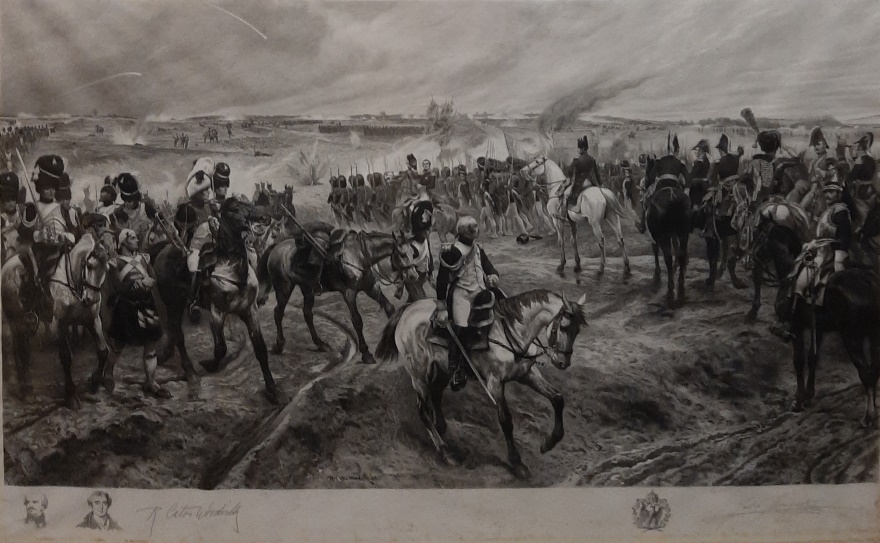
No. 105
105. WOODVILLE, Richard Caton, Jr. [1856-1927] (After). JACQUET, Jules [1841-1913] (Engraver). [Napoleon with his Old Guard at the Battle of Waterloo 1815]. signed by Woodville & Jacquet. signed ‘R.Caton Woodville [18]95’ in plate, lower left margin. vignette bust portraits of von Blücher and Wellington lower left, & remarque of imperial eagle lower right. 21 ¼ x 35 ¼ inches (54.5 x 89.8 cm., entire sheet). etching (blank hmargins damaged as a result of previous framing – no loss). London: Published Henry Graves & Co. Limited, 6 Pall Mall, Copyright 1897 U.S.A. British Arts Publishers Union…, 1897. $1,000
Richard Caton Woodville Jr. was a British artist who specialized in battle scene paintings. This detailed depiction of the Battle of Waterloo, June 18, 1815, shows cavalry and infantry positions, and Napoleon on horseback in the middleground. Napoleon was defeated in the engagement by two of the armies of the Seventh Coalition, commanded by the Duke of Wellington and Field Marshal von Blücher. Napoleon abdicated four days later, and the Napoleonic Wars and the First French Empire came to an end.
PORTRAITS
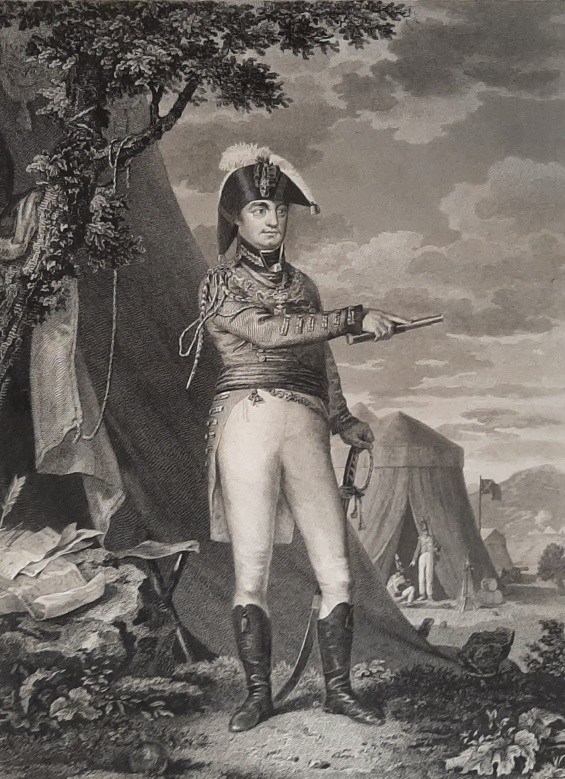
No. 106
106. (BERESFORD). L’ÉVÊQUE, Henri [1769-1832]. Marchal Lord Beresford, K.B. General Comandante in Chefe do Exercito Portugueze. 22 ¼ x 15 7/8 (22.25 x 40.3 cm., size of sheet). engraving (light marginal foxing & light dampstain to upper margin, long repaired tear to lower left not affecting image). np: [c1809]. $375
William Beresford [1768-1834] was appointed Marshal and Commander-in-Chief of the Portuguese Army in 1809 on the recommendation of Sir Arthur Wellesley, who took over command of the Anglo-Portuguese troops. During the Peninsular War he was present at the battles of Coruña, Busaco, Albuera, Badajoz, Salamanca, Vittoria, the Pyrenees, Nivelle, Nive, Orthez and Toulouse. His Peninsular Gold Medal had seven clasps – bested only by the Duke of Wellington’s, which had nine.
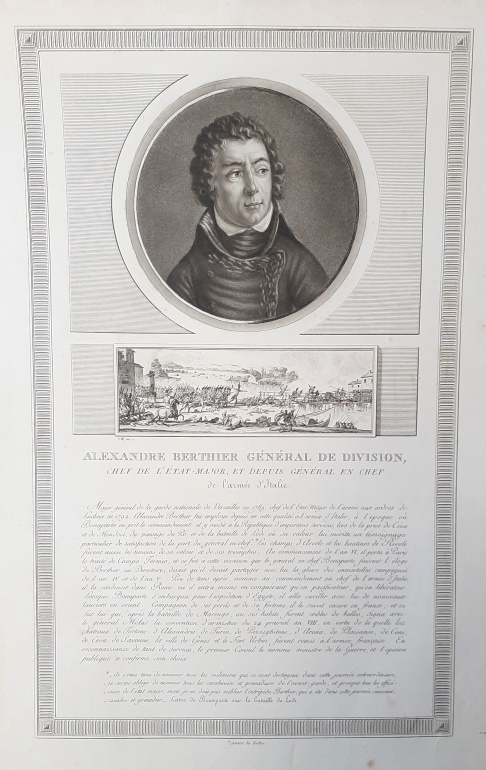
No. 107
107. (BERTHIER). LEVACHER, Charles François Gabriel [1760-1820] (Engraver). Alexandre Berthier Général De Division, Chef De L’État-Major, Et Depuis Général En Chef de l’armée d’Italie. 18 ¾ x 11 ¾ inches (47.6 x 29.8 cm., entire sheet). the aquatint portrait roundel by Levachez 12.5 cm. in diameter, the vignette etching below, 4.5 x 13.6 cm., by Jean Duplessi-Bertaux, depicting the Battle of Lodi. aquatint & etching (foxing to margins). [Paris: 1802]. $125
Louis-Alexandre Berthier (1753-1815), Prince of Neuchâtel and Valangin, Prince of Wagram, was a French Marshal of the Empire who served during the French Revolutionary Wars and the Napoleonic Wars, seeing action at Rivoli, Lodi, in Egypt, and at Marengo, Austerlitz, Jena and Friedland. He was twice Minister of War of France and served as chief of staff to Napoleon Bonaparte. Published in Claude Fauchet’s ‘Tableaux historiques de la Révolution Française’, Paris, 1802.

No. 108
108. (CHAMPIONNET). LEVACHER, Charles François Gabriel [1760-1820] (Engraver). Championnet, Successivement Général En Chef De L’Armée De Naples, De L’Armée Des Alpes, et des armées réuinis des Alpes et d’Italie. 18 ¾ x 11 ¾ inches (47.6 x 29.8 cm., entire sheet). the aquatint portrait roundel by Levachez 12.2 cm. in diameter, the vignette etching below, 4.5 x 13.6 cm., depicting the French entry into Naples by Jean Duplessi-Bertaux. aquatint & etching (foxing to margins). [Paris: 1802]. $125
Jean-Étienne Vachier Championnet [1762-1800] became commander-in-chief of the Army of Rome in 1798 and of the Army of Italy in 1799. According to Napoleon, he "was brave, full of zeal, active, devoted to his country; he was a good General of Division, an indifferent Commander-in-Chief." (Wikipedia) His is one of the names inscribed under the Arc de Triomphe. Published in Claude Fauchet’s ‘Tableaux historiques de la Révolution Française’, Paris, 1802.
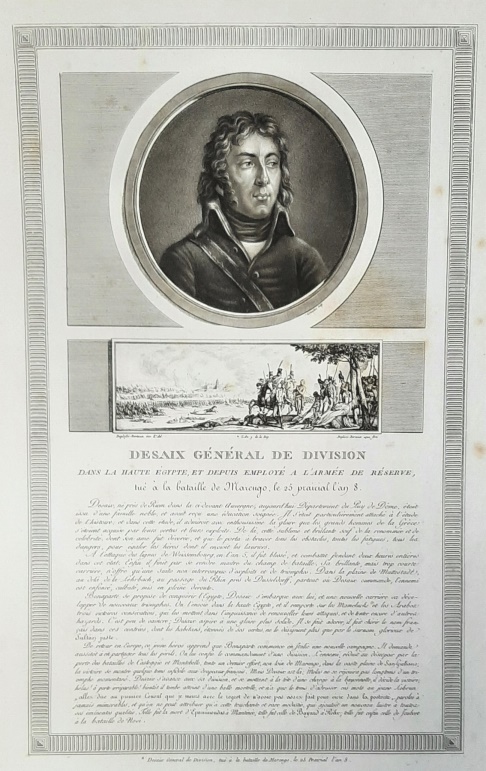
No. 109
109. (DESAIX). LEVACHER, Charles François Gabriel [1760-1820] (Engraver). Desaix Général De Division Dans La Haute Égypte. Et Depuis Employé À L’Armée De Réserve, tué à la bataille de Marengo, le 25 prairial l’an 8. 18 ¾ x 11 ¾ inches (47.6 x 29.8 cm., entire sheet). the aquatint portrait roundel by Levachez 12.4 cm. in diameter, the vignette etching below, 4.6 x 13.7 cm., by Jean Duplessi-Bertaux, depicting of the death of Desaix at the Battle of Marengo. aquatint & etching (light foxing, some browning to margins). [Paris: 1802]. $125
Louis-Charles-Antoine Desaix [1768-1800] was considered one of the greatest generals of the French Revolutionary Wars. Napoleon chose him to participate in the expeditionary force sent to Egypt, where his division bore the brunt of the Mamluk attack at the Battle of the Pyramids, and he secured victories over Murad Bey in Upper Egypt. Desaix was killed at the Battle of Marengo in 1800. Napoleon erected two monuments in his honour and his name was written on the face of the Arc de Triomphe. Published in Claude Fauchet’s ‘Tableaux historiques de la Révolution Française’, Paris, 1802.
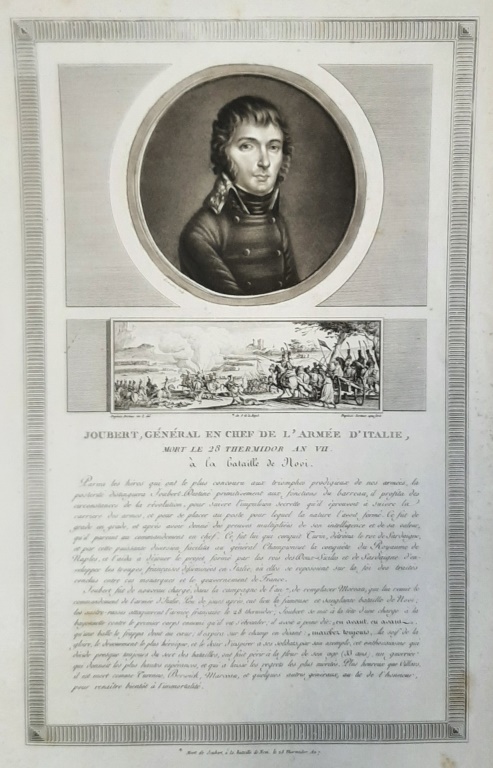
No. 110
110. (JOUBERT). LEVACHER, Charles François Gabriel [1760-1820] (Engraver). Joubert, Général En Chef De L’Armée D’Italie, Mort Le 28 Thermidor An VII à la bataille de Novi. 18 ¾ x 11 ¾ inches (47.6 x 29.8 cm., entire sheet). the aquatint portrait roundel by Levachez 12.6 cm. in diameter, the vignette etching below, 4.6 x 13.6 cm., by Jean Duplessi-Bertaux depicting the death of Joubert at the Battle of Novi. aquatint & etching (some foxing & browning to margins). [Paris: 1802]. $125
Barthélemy Catherine Joubert [1769-1799] In the campaign of 1796, Joubert became part of Napoleon Bonaparte's overall command, and fought at Milessimo, Lodi and Castiglione. Napoleon made him a general of division in December 1796, and repeatedly selected him for the command of important detachments. He participated in the Battle of Rivoli, and during the invasion of Austria he commanded the detached left wing of Bonaparte's army in the Tyrol with great distinction. He subsequently held commands in the Low Countries, on the Rhine and in the Italian Peninsula, and took over the command in Italy from Jean Moreau about the middle of July 1799. He was killed at the Battle of Novi. Published in Claude Fauchet’s ‘Tableaux historiques de la Révolution Française’, Paris, 1802.
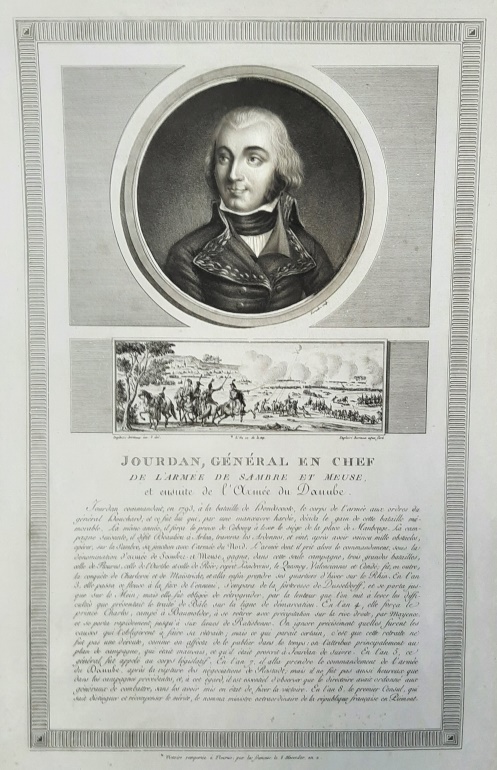
No. 111
111. (JOURDAN). LEVACHER, Charles François Gabriel [1760-1820] (Engraver). Jourdan, Général En Chef De L’Armée De Sambre Et Meuse, et ensuite de l’Armée du Danube. 18 ¾ x 11 ¾ inches (47.6 x 29.8 cm., entire sheet). the aquatint portrait roundel by Levachez 12.6 cm. in diameter, the vignette etching below, 4.7 x 13.8 cm., by Jean Duplessi-Bertaux. aquatint & etching (some browning & foxing to margins). [Paris: 1802]. $125
Jean-Baptiste Jourdan was one of the most successful commanders of the French Revolutionary Army. Under the Empire he was rewarded by Napoleon with the title of Marshal but he did not fare well during the Peninsular Wars - a major defeat at the Battle of Vitoria, on 21 June 1813, resulted in the Empire's permanent loss of Spain. Published in Claude Fauchet’s ‘Tableaux historiques de la Révolution Française’, Paris, 1802.
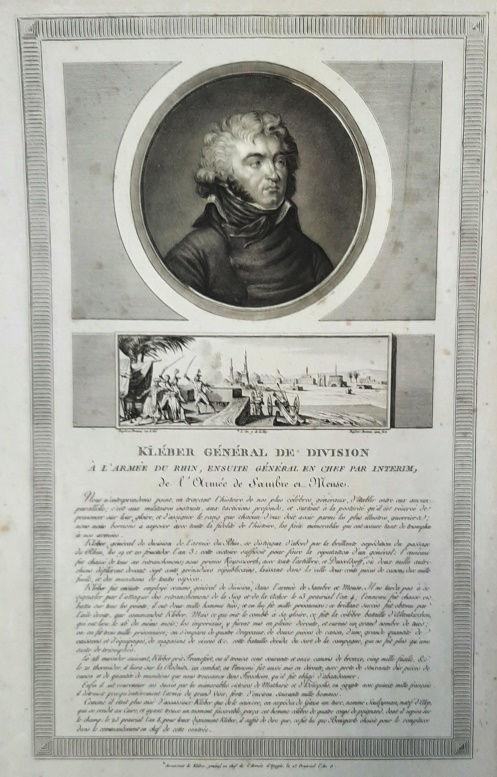
No. 112
112. (KLÉBER). LEVACHER, Charles François Gabriel [1760-1820] (Engraver). Kléber Général De Division À L’Armée Du Rhin, Ensuite Général En Chef Par Interim, de l’Armée de Sambre et Meuse. 18 ¾ x 11 ¾ inches (47.6 x 29.8 cm., entire sheet). the aquatint portrait roundel by Levachez 12.7 cm. in diameter, the vignette etching below, 4.6 x 13.8 cm., by Jean Duplessi-Bertaux, depicting Kléber’s assassination in Cairo. aquatint & etching (some browning to margins & some foxing). [Paris: 1802]. $125
Jean-Baptiste Kléber [1753-1800] accompanied Napoleon in the Egyptian Campaign, 1898-99, and was named commander of the French forces there by Napoleon when he returned to France. He was assassinated by a student in Cairo in 1800. Published in Claude Fauchet’s ‘Tableaux historiques de la Révolution Française’, Paris, 1802.
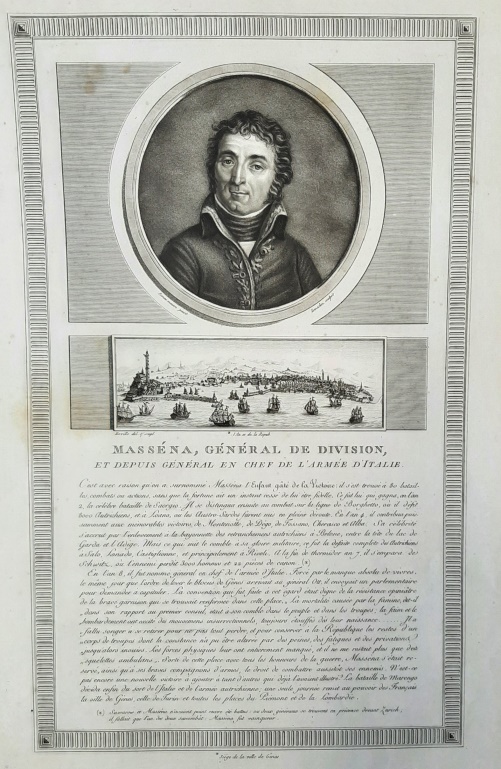
No. 113
113. (MASSÉNA). LEVACHER, Charles François Gabriel [1760-1820] (Engraver). Masséna, Général De Divison, Et Depuis Général En Chef De L’Armée D’Italie. 18 ¾ x 11 ¾ inches (47.6 x 29.8 cm., entire sheet). the aquatint portrait roundel by Levachez 12.5 cm. in diameter, the vignette etching below, 4.6 x 13.8 cm., depicting the Siege of Genoa, by Jean Baptiste Réville. aquatint & etching (some browning to margins & some foxing, marginal tears). [Paris: 1802]. $125
André Masséna, Duke of Rivoli, Prince of Essling [1758-1817] became one of Bonaparte's most important subordinates during the campaign in Italy from 1796-1797. He played a significant role in the battles of Montenotte and Dego, and took a leading role at the battles of Lonato, Castiglione, Bassano, Caldiero and Arcola, as well as the Battle of Rivoli and the fall of Mantua. He conducted an important campaign in Switzerland in 1799 against the Russians, and in 1800 he managed to hold off the Austrians for sixty days at the siege of Genoa in Italy, which allowed Napoleon to ultimately defeat the Austrian army at Marengo. In 1804 he was named a Marshal of the Empire by Napoleon and in 1808 he was granted his first ducal victory title as chief of Rivoli. For his actions at the Battles of Aspern-Essling and Wagram he was honoured with the title of Prince of Essling. After several initial victories as commander of the French army in Portugal he was eventually forced to retreat to the Spanish frontier. Published in Claude Fauchet’s ‘Tableaux historiques de la Révolution Française’, Paris, 1802.
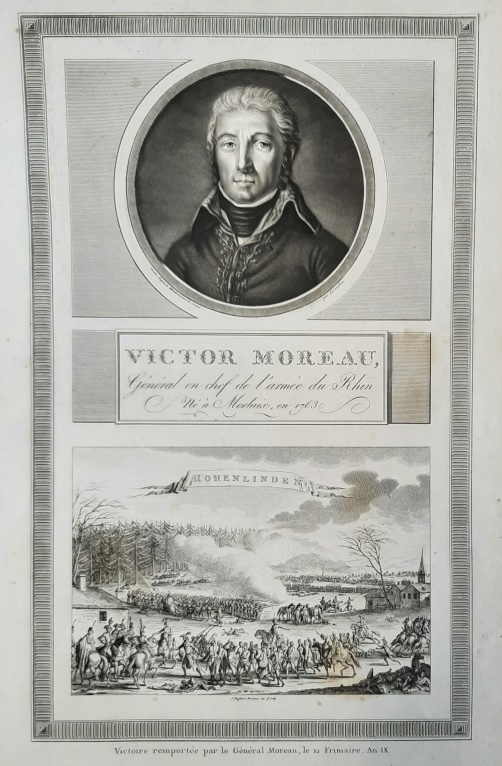
No. 114
114. (MOREAU). LEVACHER, Charles François Gabriel [1760-1820] (Engraver). Victor Moreau, Général en chef de l’armée du Rhin Né à Morlaix, en 1763. 18 ¾ x 11 ¾ inches (47.6 x 29.8 cm., entire sheet). the aquatint portrait roundel by Levachez 12.6 cm. in diameter, the vignette etching below, 12.7 x 18.4 cm., by Jean Duplessi-Bertaux, depicting the battle of Hohenlinden. aquatint & etching (some browning & foxing to margins). [Paris: 1802]. $125
Jean-Victor-Marie Moreau [1763-1813] played a minor role in the military coup d’état of 18 Brumaire (Nov. 9, 1799) that brought Bonaparte to power. Bonaparte rewarded him with the command of the Army of the Rhine and on Dec. 3, 1800, Moreau decisively defeated the Austrians at Hohenlinden. He played a part in Pichegru’s plot to overthrow Napoleon, for which he was arrested and banished to America in 1804. Published in Claude Fauchet’s ‘Tableaux historiques de la Révolution Française’, Paris, 1802.

No. 115
115. (WELLINGTON). SHARPE, Michael William [1776?-1840] (After). SAY, William [1768-1834] (Engraver). The Army [Arthur Wellesley, 1st Duke of Wellington]. 20 1/4 x 16 3/8 inches (51.4 x 41.6 cm., size of sheet). mezzotint (several tears to image – narrow one-inch stain at lower centre, some foxing to margins & lower right corner chipped). London: Sams, April 1828. $500
“Wellesley rose to prominence as a general during the Peninsular campaign of the Napoleonic Wars, and was promoted to the rank of field marshal after leading the allied forces to victory against the French Empire at the Battle of Vitoria in 1813. Following Napoleon's exile in 1814, he served as the ambassador to France and was granted a dukedom. During the Hundred Days in 1815, he commanded the allied army which, together with a Prussian Army under Field Marshal Gebhard von Blücher, defeated Napoleon at Waterloo. Wellington's battle record is exemplary; he ultimately participated in some 60 battles during the course of his military career.” (Wikipedia)
This ¾ length portrait showing Wellington [1769-1852] wearing his chain of office and raising a glass in toast was published three months after he began his first term of office as Prime Minister of England.
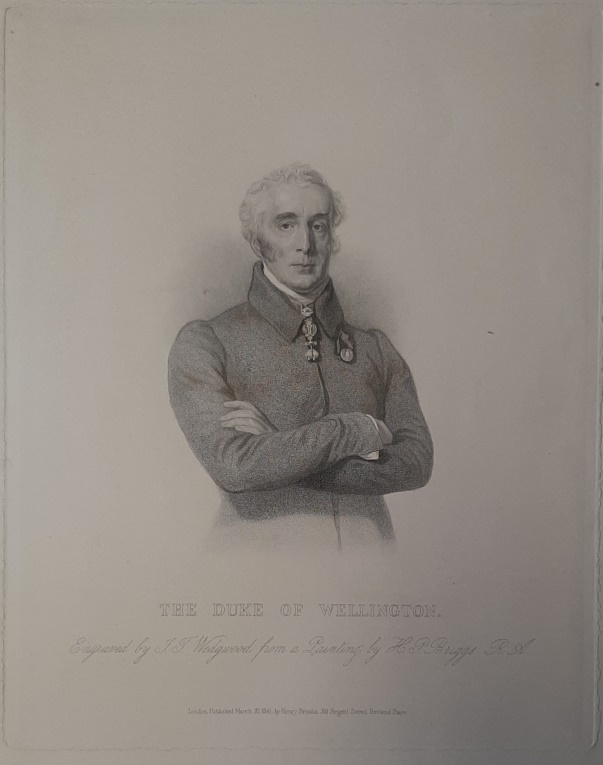
No. 116
116. (WELLINGTON). BRIGGS, Henry Perronet [1792-1844] (After). WEDGEWOOD, John Taylor [1783-1856] (Engraver). The Duke Of Wellington. 10 x 8 inches (25.4 x 20.3 cm. size of image). engraving (horizontal discolouration at centre & short tears, creases & spots to margins). London: March 20, 1841. $300
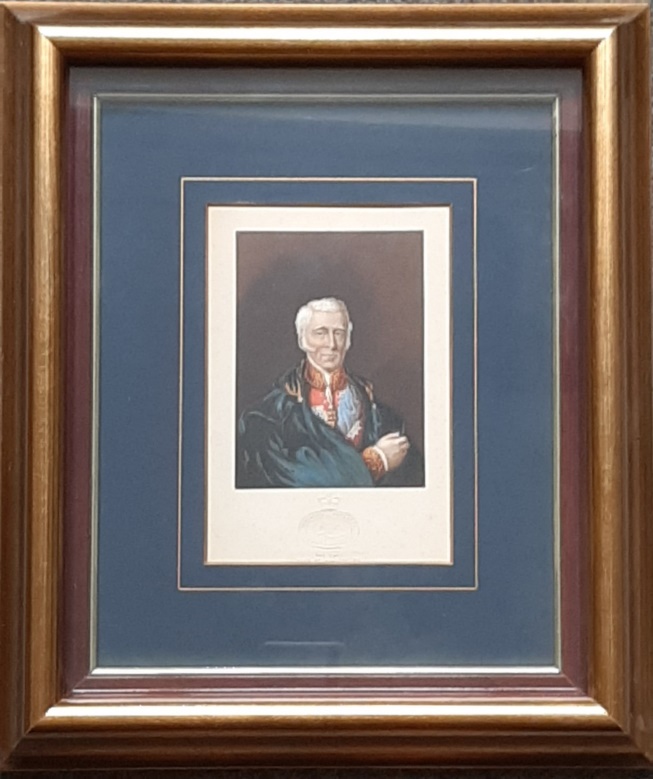
No. 117
117. (WELLINGTON). BAXTER, George [1804-1867]. The Late Duke Of Wellington. 4 5/8 x 3 3/8 inches (11.7 x 8.6 cm., size of image). engraving printed in colours with oil-based inks. matted & framed. [London: 1853]. $400
Wellington is shown in uniform wearing the Ribbon and Star of the Garter amongst other decorations.
Baxter print, No 226.